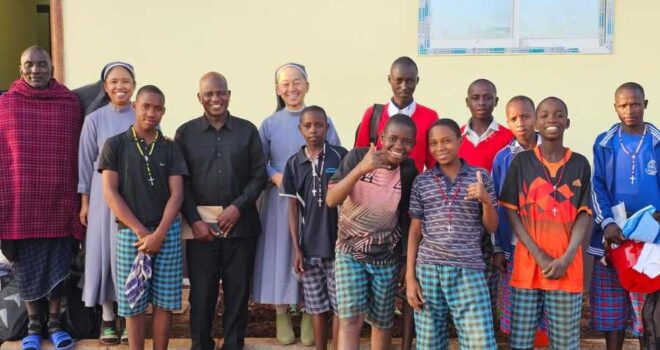When Venerable Aloysius Schwartz sent out an S.O.S. for American clergy in post-war Korea, only one American priest came to help. In the void, the Sisters of Mary stepped forward. Sixty years later, they haven’t stopped.
In May of 1967 a small advertisement appeared in the National Catholic Reporter and on the back cover of America Magazine. “HELP US!” The bold-faced, all-caps plea was made by an unknown priest from America, Fr. Aloysius Schwartz, who had left everything behind to serve the poor, diseased, and orphaned on the southern peninsula of Korea.
The ad, written and paid for by “Fr. Al” went on:
Once you have heard the cry of the poor, you can go back to the old dispensation with its long cars, loam carpets, and juicy steaks—but it will no longer be the same: a voice will constantly remind you it is all folly, all wrong. If you have heard this cry—ever so faintly—this notice is meant for you.
At the time, the 37-year-old Washington D.C. native was elbow deep in his care for hundreds of orphans and providing housing for the societally-ostracized. Unwed mothers, street urchins, the tubercular, diseased, and infirmed all began to drag themselves to the mysterious priest. Fr. Al was one priest doing the work of a dozen. South Korea was suffering the ravages of war, and countless thousands were in dire need of care.
He sent the S.O.S. to the Catholic periodicals because he needed clergy to catechize, assist in celebrating Masses, administer the sacraments, and to help him serve the poor.
In the fall of ‘67, four American priests saw the ad and took separate flights to South Korea, where they were immediately sent out by Fr. Al into the Korea’s most brokenhearted places.
Within a year, three of the American priests left South Korea and never returned. The work was too much for them.
One priest, however, stayed—Monsignor James Golasinski. The Texan priest, who served alongside Fr. Al for ten years in Busan, vividly remembers Fr. Al’s work ethic. He’d never seen anything resembling it; Msgr. Golasinski was watching a priest put an entire country back on his back.
“People say that St. Vincent de Paul was the great apostle of charity and that Fr. Al Schwartz based his entire missionary life on his,” said Monsignor Golasinski, who though in his 90s, still celebrates Mass most days. “But I’ve told people that Msgr. Aloysius Schwartz accomplished more than St. Vincent de Paul. What Fr. Al managed to do is beyond the pale. I was there, and I saw what happened.”
Why dig up an old memory of the one American priest who stayed?
Because Fr. Al found another way of getting help: the Sisters of Mary. In the 1960s, these consecrated women told the priest they would never leave his side. Though their work often demanded an acceptance of revolting, dangerous, and tireless acts of care for the poor, the religious congregation Fr. Al founded in 1964 kept growing.
On August 15, 383 Sisters of Mary will celebrate their 60th anniversary in their fifteen Boystown and Girlstown communities throughout the world.
Msgr. Golasinski was there to see the Sisters of Mary’s non-stop work for the poor from the beginning. Daily, he watched the bands of white-habited sisters disappear daily into the most disregarded places of Korea’s southeastern peninsula, where they tended to ill-nourished bodies crumpled on sidewalks, insane men in cardboard boxes, and shivering men and women beneath Busan Bridge. “[They] were visiting people who lived like animals,” said Msgr. Golasinski. “Korea had been ripped in two, and they were there to see it. They saw things no one sees.” But they were prepared for it. Fr. Al once told them: “The way we serve is to wear a constant crown of thorns.”
Today, the Sisters of Mary religious community serves more than 20,000 teenagers in authentically Catholic Boystown and Girlstown communities, where they are instructed and given a high school education for five years. In total, the Sisters of Mary have helped to put more than 170,000 children through high school. Thousands of them would be dead if the sisters hadn’t entered their villages—two-by-two—to pull them from the grip of traffickers, rapists, drug runners, gangs, murderers, and the violence of poverty. It is this cycle of poverty that the sisters work each day to end.
The level of their success cannot be mapped; it is incomprehensible.
Boystown and Girlstown graduates attend universities, where some go on to run companies. Their students become teachers, lawyers, artists, and bricklayers, and run family farms. Some enter seminaries and cloisters to become priests and nuns. Others move into parishes and volunteer as catechists, lectors, and spiritual big sisters and brothers to the poor.
How did this movement of grace begin?
At the birth of his priesthood in the winter of 1957, Fr. Al began to make frequent visits into Korea’s vast Dickensian state-run orphanages. After some time, he saw the government institutions as soulless and even “demonic.” The scenes haunted him; emaciated, wordless children stared at him with joyless eyes.
In the spring of 1964, Fr. Al placed an advertisement in Korea’s largest Catholic weekly newspaper, requesting the immediate assistance of young women willing to dedicate their lives in service to orphans. It was Fr. Al’s intention to begin his own orphanages—ones in which parentless children would be mothered back to health by adults who loved them.
A week later, his mailbox began to fill with responses from young women throughout Korea. He sensed the deluge of responses were from a population of young women who, whether they said it or not, wanted to live as nuns. Perhaps because Fr. Al has consecrated his priesthood to Our Lady the Virgin of the Poor, he knew an untapped reservoir of women were looking to mother children as Mary did for the helpless Christ child.
He was honest from the beginning, telling the interviewees that they would need to awaken early each morning brimming with energy to bring life back into the souls of street children. He was blunt: their lives would demand a devotedness to prayer and abnegation, an unrelenting work ethic, and most importantly a desire to become a suffering servant. He said that it was time Korea’s broken children understood Christ’s love through maternal care.
The majority of the applicants were daughters of poor families. There was a modestness in their bearing; they didn’t dress up for job interviews. And one after the other, Fr. Al listened to their stories and gained an understanding of the many wounds they carried. Fr. Al sensed, though, that it would be their removal of the orphans’ wounds that would heal their own.
And so the Mariahwe was born, meaning “Sisters of Mary.” The day was August 15, 1964, the Feast of the Assumption. Fr. Al’s instructions to the new sisters were simple: Try your best. Even in the littlest things you do for the children, offer to Jesus.
He wrote to a friend explaining his reason for starting the order, which was initially established and known as the Maria Pomohwe (Maria Orphan-Mother Society): “[they] were founded to seek out and serve not just the poor, but the poorest of the most destitute, and those most lowly.”
“When he started it all, he knew he didn’t want overly educated women helping him with the work,” Msgr. Golaskinski said. “Confucianism in Korea has always put a stress on schooling and education, but Fr. Al didn’t want or need that. As soon as a young lady would enter the Mariahwe and Fr. Al saw the makings of holiness, he didn’t spend much time with her novitiate; he was hoping she would dive right in to help the poor.”
Twelve women, all in their twenties, were chosen. They would join him in the cross of unrequited care to the forgotten race of people Mary addressed in Banneux. These aspirants were the future mother-sisters who would grow in force and number and begin to spread like a clement wave of care across the world.
Within a year of founding the Mariahwe, the overcrowded orphanages from all over Busan wanted to release children into the Sisters’ care.
“Fr. Al was a modern-day John Bosco who left everything for the poor,” Msgr. Golasinski said. “Importantly, though, he modeled everything after St. Vincent de Paul—because he knew what the saint did with the power of Louise de Marillac and the holy women she recruited—the women who spread out everywhere to serve the poorest of the poor.”
HOW YOU CAN HELP
The Sisters of Mary World Villages for Children is a nonprofit organization that financially supports the Sisters of Mary in their quest to help children break free from a life of poverty and trafficking and lead them to Christ and the Catholic faith. SOM-WVC provides food, shelter, clothing, medical expenses, Catholic education and vocational training to more than 20,000 children in Boystowns and Girlstowns around the world. To donate to the Sisters of Mary, please visit: WorldVillages.org/poverty.
Photo retrieved from WorldVilliages.org










